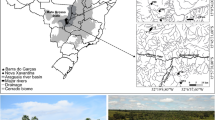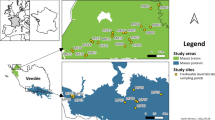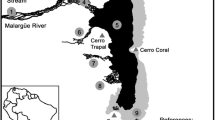Abstract
Mediterranean wetlands represent unique repositories of biodiversity, but these ecosystems are increasingly threatened by human-induced habitat loss. Seventy percent of Greek wetlands (ponds, mires, marshes, etc.) have been lost in the past 80 years due to human intervention. In Greece habitat types of mires, listed in Directive 92/43/EEC, have been recorded in a few locations, one of the most important is Kalodiki wetland. Eutrophication key elements were determined at four sampling stations throughout 1 year in order to monitor the trophic conditions. Moreover, the zooplankton community was described as biological element relevant in the assessment of the ecological status of Kalodiki wetland. Kalodiki wetland exhibits nutrient concentrations corresponding to eutrophic conditions while according to chlorophyll-a values it is classified between mesotrophic and eutrophic status depending mostly on the sampling period. As concerning zooplankton community, it appears poor in species and dominated by small-sized organisms, which is generally typical of eutrophic, disturbed systems. Differences among zooplankton assemblages over seasons as well as among sampling sites highlight the role of both abiotic and biotic factors.
Similar content being viewed by others
References
Angeler, D., Alvarez-Cobelas, M., Sanchez-Carrillo, S., & Rodrigo, M. (2002). Assessment of exotic fish impacts on water quality and zooplankton in a degraded semi-arid floodplain wetland. Aquatic Science, 64, 76–86
Angeler, D., & Moreno, J. (2007). Zooplankton community resilience after press-type anthropogenic stress in temporary ponds. Ecological Applications, 17(4), 1105–1115.
Antonopoulos, A., Kagalou, I., Michaloudi, E., & Leonardos, I. (2008). Limnological features of a shallow eutrophic lake (Lake Pamvotis, Greece) with emphasis on zooplankton community structure. Oceanological and Hydrobiological studies, XXXVII (7–20), 7–19.
APHA (1989). Standard methods for the examination of water and wastewater, 17th Edn. In A. Eaton , E. Rice, & R. Baird (Eds.). Washington.
Arapis, Th. (1998). Environmental study of Kalamas river and Kalodiki wetland. Ministry of Environment (in Greek). Athens, Greece.
Beklioglu, M., Romo, S., Kagalou, I., Ouintana, X., & Becares, E. (2007). State of the art in the functioning of shallow Mediterranean lakes: Workshop conclusions. Hydrobiologia, 584, 317–326.
Botis, A., Bouzinos, A., & Christians, K. (1993). The geology and paleoecology of the Kalodiki peatland. W. Greece, Helsinki: Int. Peat Journal 5.
Crisman, T., Mitraki, Ch., & Zalidis, G. (2005). Integrating vertical and horizontal approaches for management of shallow lakes and wetlands. Ecological Engineering, 24, 379–389
Dimopoulos, P., Sykora, K., Gilissen, C., Wiecherink, D., & Georgiadis, Th. (2005). Vegetation ecology of Kalodiki fen (NW Greece). Biologia Bratislava, 60/1, 69–82
Duncan, A., & Schemer, F. (1988). Fish pressure on ecosystems: Dynamic, holistic indices. In S. S. De Silva (Ed.), Proceedings of the symposium on reservoir fishery management and development in Asia (pp. 176–182). Ottawa.
Fahd, K., Serrano, L., & Toja, J. (2000). Crustacean and rotifer composition of temporary ponds in the Donana National Park (SW Spain) during floods. Hydrobiologia, 436, 41–49.
Fontaneto, D., Segers, H., & Melane, G. (2008). Marine rotifers from the Adriatic Sea, with description of Lecane sp. Journal of the Marine Biological Association of the United Kingdom, 88(2), 253–258.
Gerakis, P. (1993). Conservation and management of Greek wetlands workshop, April 1989 (p. 493). Switzerland, Thessaloniki, Greece: IUCN, Gland.
Guevara, G., Lozano, P., & Reinoso, G. (2009). Horizontal and seasonal patterns of tropical zooplankton from eutrophic Prado reservoir (Colombia). Limnologica, 39, 128–139.
Gyllstrom, M., & Hanson, I. A. (2005). The role of climate in shaping zooplankton communities of shallow lakes. Limnology and Oceanography, 50(6), 2008–2021.
Havens, K. E., James, R. T., East, T. L., & Smith, V. H. (2003). N:P ratios, light limitation, and cyanobacterial dominance in a subtropical lake impacted by non-point source nutrient pollution. Environmental Pollution, 122, 379–390.
Jeppesen, E., Sondegaard, E., Jensen, P., Mortensen, A., Hansen, A., & Jorgensen, T. (1998). Major perturbation in biological structure and dynamics of a shallow hypertrophic lake following a reduction in sewage loading: An 18 year study in Lake Sobygaard, Denmark. Ecosystem, 1, 250–267.
Kagalou, I., Papastergiadou, E., Beza, P., & Giannouris, E. (2006). Assessment of the trophic state of Kalodiki wetland, western Greece. Fresenius Environmental Bulletin, 15(2), 136–140.
Kippen-Kuczynska, N., & Nagengast, B. (2006). The influence of the spatial structure of hydromacrophytes and differentiating habitat on the structure of rotifer and cladoceran communities. Hydrobiologia, 559, 203–212
Leira, M., & Cantonati, M. (2008). Effects of water level fluctuations on lakes: An annotated bibliography. Hydrobiologia, 613, 171–184.
Leonardos, I., Kagalou, I., Tsoumani, M., & Economidis, P. S. (2008). Fish fauna in a Greek lake: Biodiversity, introduced fish species over a 80-year period and their impacts on the ecosystem. Ecology of Freshwater Fish, 17, 165–173.
Mantzafleri, N., Psilovikos, A., & Blanta, A. (2009). Water quality monitoring and modelling in Lake Kastoria, using GIS. Assessment and management of pollution sources. Water Resources Management. doi:10.1007/s11269-009-9431-4.
Meerhoff, M., Mazzeo, N., Moss, B., & Rodriguez-Gallego, L. (2003). The structuring role of free-floating versus submerged plants in a subtropical shallow lake. Aquatic Ecology, 37, 377–391.
Mitraki, Ch., Crisman, T., & Zalidis, G. (2004). Lake Koronia, Greece: Shift from autotrophy to heterotrophy with cultural eutrophication and progressive water-level reduction. In Proceeding of lake shores conference (pp. 68) Kostanz, June 2003.
Moss, B., Stephen, D., Balayla, D., Bécares, E., Collings, S. E., Fernández-Aláez, C. et al. (2004). Continental-scale patterns of nutrient and fish effects on shallow wetland lakes: Synthesis of a pan-European mesocosm experiment. Freshwater Biology, 49, 1633–1650.
Moustaka-Gouni, M., Vardaka, E., Michaloudi, E., Kormas, K., Tryfon, E., Mihalatou, H., et al. (2006). Plankton food web structure in a eutrophic polymictic lake with a history of toxic cyanobacterial blooms’. Limnologya and Oceanographic, 51(1), 715–727.
Naselli-Flores, L., & Barone, R. (2005). Water–level fluctuations in Mediterranean reservoirs: Setting a dewatering threshold as a management tool to improve water quality. Hydrobiologia, 548, 85–99.
OECD (1982). Eutrophication of waters. Monitoring, assessment and control. Final Report, Paris.
Ortega-Mayagoitia, E., Armengol, X., & Rojo, C. (2000). Structure and dynamics of zooplankton in a semi-arid wetland, the National Park Las Tablas de Daimel (Spain). Wetlands, 20, 629–638.
Papastergiadou, E., Retalis, A., Apostalakis, A., & Georgiadis, Th. (2008). Environmental monitoring of spatio-temporal changes using remote sensing and GIS in a Mediterranean wetland of Northern Greece. Water Resources Management, 22, 579–594.
Pinto-Coelho, R., Pinel-Allol, B., Methot, G., & Havens, K. (2005). Crustacean zooplankton in lakes and reservoirs of temperate and tropical regions: Variations with trophic status. Canadian Journal of Fisheries and Aquatic Science, 62, 348–361.
Romo, S., Miracle, M., Villena, M. J., Rueda, J., Ferriol, C., & Vicente, E. (2004). Mesocosm experiments on nutrient and fish effects on shallow lake food webs in a Mediterranean climate. Freshwater Biology, 49, 593–1607.
Sarika-Hatzinikolaou, M. (1994). Floristic and phytosociological study of aquatic ecosystems of Epirus. Ph.D. Thesis, University of Athens, Greece.
Sas, H. (1989). Lake restoration by reduction of nutrient loading: Expectations, experiences, extrapolations. S. Augustin: Academia Verlag Richarz
Seminara, M., Vagaggini, D., & Margaritora, F. (2008). Differential responses of zooplankton assemblages to environmental variation in temporary and permanent ponds. Aquatic Ecology, 42, 129–140.
ter Braak, C. J. F. (1987). Ordination. In R. H. G. Jongman, C. J. F. ter Braak, & O. F. R. van Tongeren (Eds.), Data analysis in community and landscape ecology (pp. 91–173). Wageningen: Pudoc.
Author information
Authors and Affiliations
Corresponding author
Rights and permissions
About this article
Cite this article
Kagalou, I.I., Kosiori, A. & Leonardos, I.D. Assessing the zooplankton community and environmental factors in a Mediterranean wetland. Environ Monit Assess 170, 445–455 (2010). https://doi.org/10.1007/s10661-009-1245-6
Received:
Accepted:
Published:
Issue Date:
DOI: https://doi.org/10.1007/s10661-009-1245-6




